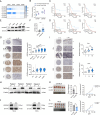Inhibiting CMTM4 reverses the immunosuppressive function of myeloid-derived suppressor cells and augments immunotherapy response in cervical cancer
- PMID: 40514067
- PMCID: PMC12164624
- DOI: 10.1136/jitc-2025-011776
Inhibiting CMTM4 reverses the immunosuppressive function of myeloid-derived suppressor cells and augments immunotherapy response in cervical cancer
Abstract
CKLF (chemokine-like factor)-like MARVEL transmembrane domain-containing family member 4 (CMTM4), belonging to the CMTM family of transmembrane domain proteins, plays a significant role in the initiation, progression, and metastasis of cancer. Nevertheless, its involvement in tumor immunity remains elusive. In the present investigation, we observed an upregulation of CMTM4 expression in patients with cervical cancer (CC), which also serves as a prognostic indicator for patients with CC. In vitro experiments and therapeutic models have demonstrated that CMTM4 upregulates the expansion of myeloid-derived suppressor cells (MDSCs) in the tumor microenvironment via the CCL2 (C-C motif chemokine ligand 2)/CCR2 (C-C motif chemokine ligand 2) and IL-6 (interleukin-6)/GP130 (glycoprotein 130) axes. This process exerts immunosuppressive effects and promotes the occurrence and progression of CC. Mechanistically, CMTM4 interacts and stabilizes PHB2 (prohibitin 2) through post-translational modification, which further induces activation of the STING (stimulator of interferon genes)/TBK1 (TANK-binding kinase 1)/STAT6 (signal transducer and activator of transcription 6) pathway, facilitating the nuclear translocation of STAT6 which binds to the CCL2/IL-6 promoter, leading to the upregulation of CCL2/IL-6 transcription expression. Importantly, targeting CMTM4 with CMTM4-small interfering RNA enhanced the effectiveness of anti-programmed cell death protein 1 (anti-PD-1) therapy. Our study identifies CMTM4 as a crucial determinant guiding the homing of MDSCs to CC, thereby contributing to MDSCs-mediated immune suppression and tumor progression. The combination of CMTM4 inhibition and anti-PD-1 treatment shows promising antitumor efficacy against CC. These findings offer novel insights into the tumor microenvironment and have the potential to inform the development of innovative immunotherapy approaches for CC.
Keywords: Cervical Cancer; Immunosuppression; Immunotherapy; Myeloid-derived suppressor cell - MDSC; Tumor microenvironment - TME.
© Author(s) (or their employer(s)) 2025. Re-use permitted under CC BY-NC. No commercial re-use. See rights and permissions. Published by BMJ Group.
Conflict of interest statement
Competing interests: None declared.
Figures







Similar articles
-
Inhibition of CMTM4 Sensitizes Cholangiocarcinoma and Hepatocellular Carcinoma to T Cell-Mediated Antitumor Immunity Through PD-L1.Hepatol Commun. 2022 Jan;6(1):178-193. doi: 10.1002/hep4.1682. Epub 2021 Jul 21. Hepatol Commun. 2022. PMID: 34558800 Free PMC article.
-
Exosomal CMTM4 Induces Immunosuppressive Macrophages to Promote Ovarian Cancer Progression and Attenuate Anti-PD-1 Immunotherapy.Adv Sci (Weinh). 2025 Aug;12(30):e04436. doi: 10.1002/advs.202504436. Epub 2025 May 28. Adv Sci (Weinh). 2025. PMID: 40433989 Free PMC article.
-
CMTM6 and CMTM4 as two novel regulators of PD-L1 modulate the tumor microenvironment.Front Immunol. 2022 Jul 25;13:971428. doi: 10.3389/fimmu.2022.971428. eCollection 2022. Front Immunol. 2022. PMID: 35958549 Free PMC article. Review.
-
Modulation of tumor inflammatory signaling and drug sensitivity by CMTM4.EMBO J. 2025 Mar;44(6):1866-1883. doi: 10.1038/s44318-024-00330-y. Epub 2025 Feb 13. EMBO J. 2025. PMID: 39948411 Free PMC article.
-
[Advances in the Study of Chemokine-like Factor Superfamily Members in Tumors].Zhongguo Fei Ai Za Zhi. 2023 Jan 20;26(1):46-51. doi: 10.3779/j.issn.1009-3419.2023.106.01. Zhongguo Fei Ai Za Zhi. 2023. PMID: 36792080 Free PMC article. Review. Chinese.
References
MeSH terms
Substances
LinkOut - more resources
Full Text Sources
Medical
Research Materials
Miscellaneous
